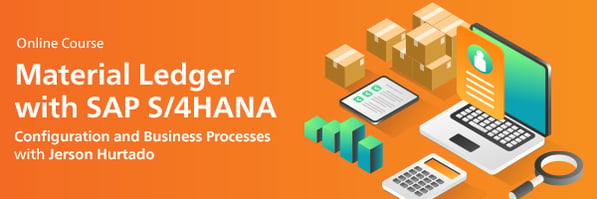Recently, we asked you for your pressing SAP Material Ledger questions so that Paul Ovigele, ERPfixers’ founder and author of Material Ledger in SAP S/4HANA: Functionality and Configuration, could answer them. Here’s what he had to say.
Q: How many currency types can be used in SAP S/4HANA Finance for inventory valuation? In SAP ECC it is three currencies.
A: In SAP S/4HANA Finance, you still have three currency types for inventory valuation. This has not changed from SAP ECC. What has changed is that you have a total of 10 currency types in the Universal Journal, of which three can be used for inventory valuation.
Q: Are the Stock-in-Transit (SIT) functionalities that are available in SAP ECC (with activation of LOG_MM_SIT) also available in SAP S/4HANA? If so, is there any difference in the functionality?
A: The SIT functionalities are also available in SAP S/4HANA. There is not much difference in the functionality itself, however. In SAP ECC, LOG_MM_SIT was an optional activation, while in SAP S/4HANA it is an “always turned on” business function. Also, with the introduction of single valuation ledgers, you could have the group or profit center transfer pricing postings in a separate ledger from the leading ledger.
Q: Is there a functionality in SAP S/4HANA to calculate intercompany transfer prices?
A: The calculation of transfer prices is not a specific functionality per se. The transfer price itself is simply a pricing condition (either in the Sales and Distribution or Profit Center Accounting module) that is set up between an intercompany customer and vendor. Therefore, the functionality is the same as a normal pricing condition. What group valuation (with the Material Ledger) adds to this is that it records the inventory value without the transfer price profit.
Q: Do we need to calculate a standard cost in profit center valuation view, in order to use PC transfer pricing?
A: No, you do not need to calculate standard cost in PC valuation, if you do not want to. In fact, you do not even need to use standard cost—you can have PC valuation with moving average cost. If you do value inventory with standard cost (but do not want to calculate it), you can update the PC valuation view with Transaction MR21.
Q: Can we set the price determination to three (in order to have a better material price analysis view), even though we do not use actual costing?
A: I have had this question before, and the reason seems to be because, with a price determination of 2 in SAP S/4HANA, you lose certain features of material price analysis that were available in SAP ECC. These features in SAP S/4HANA are only available with price determination of 3. While it is technically possible to have price determination 3 without actual cost, I would not recommend it, because price determination 3 implies that you will calculate an actual cost at the end of each month.
Q: Can we correct the "not allocated" differences using the value flow monitor?
A: No, the not allocated differences can only be viewed with the value flow monitor, but not corrected. Only the “not distributed” differences can be corrected by the value flow monitor. Note also, that in SAP S/4HANA, the value flow monitor transaction has changed to ML4HVFM.
Q: Is there a mass processing option for manually changing the actual cost components?
A: Yes, this can be done by using function module CKMMC_MANCHANG_AUTOMATED, and following the instructions in SAP Note 653117 to create an upload program.
Q: Can the parallel cost of goods manufactured (COGM) functionality be used with an extension ledger?
A: No, the parallel COGM functionality can only be used with a standard (leading or non-leading) ledger.
Q: Can we create our own balance sheet valuation method besides the three (FIFO, LIFO, lowest value) mentioned in your book?
A: Yes, you can create other balance sheet valuation methods, by defining them as valuation alternatives in Transaction OMWEB.
Q: If we calculate a daily actual cost, is there an option to post the revaluation differences to the General ledger on a daily basis?
A: The daily actual cost process that was described in the book was a way to calculate actual cost on a daily basis without updating the general ledger. It is really a way to have a snapshot of actual cost at a particular point in time (or to be used in flash reports). The only way to update the general ledger with revaluation differences is to execute the post closing step at the end of the month.
Q: Why has SAP made activating the Material Ledger mandatory since you don’t necessarily have to use it in your accounting workflows?
A: The Material Ledger in SAP S/4HANA has become the overall umbrella for inventory valuation. In SAP ECC, the inventory valuation tables (MBEW, EBEW, etc.) existed separately from the Material Ledger tables. With SAP S/4HANA, as part of the strategy of streamlining the data footprint in the system, SAP has merged inventory valuation with the Material Ledger. This way, there isn’t redundant data in both modules. Therefore, if you use inventory valuation SAP in ECC, it simply goes under another name— “Material Ledger”— in SAP S/4HANA. Plus, you have the opportunity to add extra functionality such as actual costing, parallel valuation, transfer pricing, etc.
Q: Is it better to move to activate the Material Ledger before moving to SAP S/4HANA or as part of the SAP S/4HANA implementation?
A: It depends on your business situation. If there is a business necessity to use the Material Ledger, but you have been holding out on implementing it, it may be a good idea to implement before SAP S/4HANA in order to get used to the functionality, smooth out any initial issues, and then eventually benefit from the enhanced functionality once you are on SAP S/4HANA. If you have no use for the Material Ledger functionality and are only going to activate it because it is mandatory in SAP S/4HANA then it is better to wait until that time.
Q: Can you activate the single valuation ledger after you move to SAP S/4HANA?
A: No, you cannot activate the single valuation Ledger after you move to SAP S/4HANA. The single valuation ledger is only available for customers that are doing greenfield projects. In fact, the activation of any ledger (except an extension ledger) in SAP S/4HANA is not possible unless you are starting from scratch. I think this is something that SAP will change with future releases.
Q: What do you think are the biggest benefits of using the Material Ledger?
A: There are numerous benefits to the Material Ledger. Here are some of them:
- Calculate actual cost of inventory based on periodic activity (hence no need to use moving average price)
- Compare standard cost with actual cost
- Revalue inventory, WIP, COGS, and other consumption based on actual cost
- Multiple views of Inventory according to legal view, group view, and profit center view
- Value transparency of relevant material transactions every period
The overall benefit of the Material Ledger is getting more detailed information for each of your relevant inventory transactions.
Learn more about the Material Ledger and actual costing with SAP S/4HANA here.
Learn the Material Ledger in Our Rheinwerk Course!
Managing actual costing and parallel valuation in an increasingly globalized economy is more complex than ever. This series explains core Material Ledger concepts, capabilities, and configurations. Learn how the Material Ledger helps organizations handle inventory, exchange rates, regional legal requirements, and market fluctuations. Get access to course recordings by clicking the banner below.
This post was originally published 6/2020.




Comments